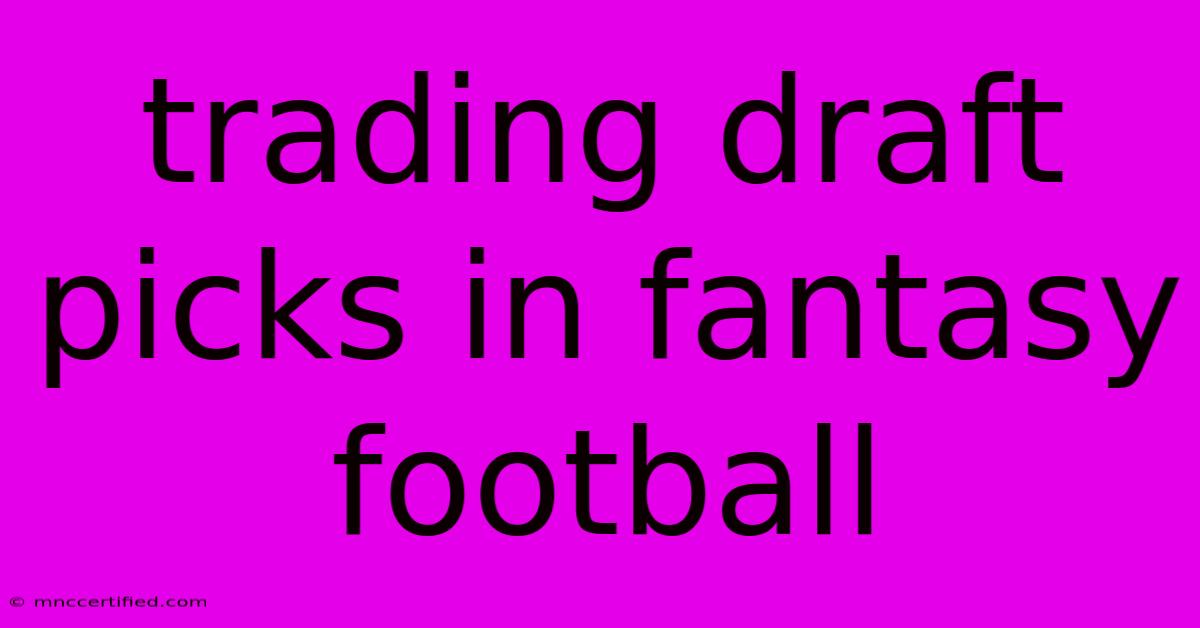Trading Draft Picks In Fantasy Football

Table of Contents
Trading Draft Picks: A Masterclass in Fantasy Football Strategy
Drafting your fantasy football team is an exciting time, but it's not just about picking players. In the realm of fantasy football strategy, trading draft picks is a powerful tool that can unlock significant advantages. Whether you're a seasoned veteran or a first-time drafter, understanding the nuances of trading draft picks can elevate your game.
The Value of Draft Picks: Why Trade Them?
- Flexibility: In a volatile fantasy world, unexpected player injuries or breakout stars can shift the landscape. Trading picks gives you the flexibility to adjust your strategy and acquire the players you need, when you need them.
- Gaining an Edge: Experienced fantasy managers know that the draft can be won by making the right moves. Trading picks allows you to maneuver up the draft board and secure key players, or to acquire multiple high-value players in later rounds.
- Acquiring Star Players: Sometimes, the player you want most is already gone by your draft position. Trading up can be the solution to land your dream player.
Decoding the Draft Pick Value Chart
The first step in trading draft picks is understanding their value. A draft pick value chart helps you gauge the relative worth of each pick based on historical data and consensus opinion.
Key factors influencing draft pick value:
- Round: Earlier round picks are generally more valuable.
- Pick Number: Higher picks within a round are more valuable.
- League Size and Scoring Format: Different league settings can impact draft pick values.
Trading Scenarios: Turning Picks into Assets
Scenario 1: The "Buy Low" Strategy
- Opportunity: A player you believe in has fallen in value due to perceived injury risks or recent performance.
- Trade: Offer a future pick (potentially a late-round pick) in exchange for this player.
- Outcome: If your assessment is correct, you'll acquire a valuable player at a discount, while the other manager gets a pick they might value more.
Scenario 2: The "Sell High" Strategy
- Opportunity: A player you drafted is exceeding expectations, driving up their value.
- Trade: Trade this player for a future pick or multiple picks of equal value.
- Outcome: You capitalize on the player's inflated value and secure draft assets for the future.
Scenario 3: The "Contender" Strategy
- Opportunity: Your team is already strong and you need that extra edge to win.
- Trade: Offer future picks (potentially high-round picks) for established players or key contributors.
- Outcome: You strengthen your roster immediately and increase your chances of winning.
Don't Forget the "Gut Feeling"
While charts and strategies are helpful, don't underestimate the value of your own instincts. If you feel strongly about a trade, even if it doesn't perfectly align with the charts, it might be worth exploring.
Tips for Successful Trade Negotiations
- Communicate clearly: Be direct and honest about your expectations.
- Be willing to compromise: A successful trade often involves both parties making concessions.
- Don't be afraid to walk away: If the deal doesn't feel right, don't feel pressured to accept it.
Trading draft picks is an art, not a science. But with the right knowledge, you can leverage this strategy to build a championship-caliber fantasy team.

Thank you for visiting our website wich cover about Trading Draft Picks In Fantasy Football. We hope the information provided has been useful to you. Feel free to contact us if you have any questions or need further assistance. See you next time and dont miss to bookmark.
Featured Posts
-
Daniel Lurie Levi Strauss Heir Enters Politics
Nov 09, 2024
-
Catastrophic Flooding Hits Girona Spain
Nov 09, 2024
-
How Much Does A Barry Bonds Card Worth
Nov 09, 2024
-
Londons Lord Mayors Show A Guide
Nov 09, 2024
-
Travelers Insurance Settlement Amounts
Nov 09, 2024